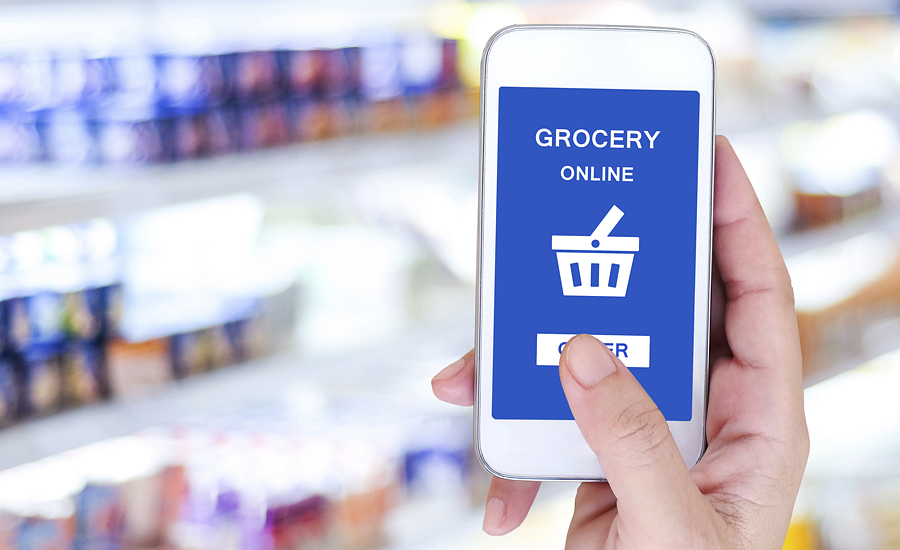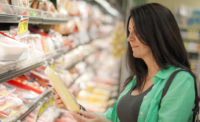E-commerce accounts for a small fraction of U.S. grocery sales, yet the number of shoppers buying groceries online, even if only occasionally, is substantial and growing rapidly.
Coresight Research, New York, estimates just 2.2% of U.S. food and beverage retail sales were online in 2018, with this number rising to around 2.7% in 2019.
But, Coresight Research’s second annual survey of grocery shopping habits found that while more than one-third of U.S. consumers now buy groceries online, 72% of those shoppers direct only a small amount of their total grocery spend online.
Here are some insights from the survey.
- Approximately 35 million increase in online grocery shoppers
Some 36.8% of respondents said they bought groceries online in the past year, up substantially from 23.1% in last year’s survey. Based on Census Bureau adult population data, that equates to roughly 35 million more consumers buying groceries online between 2018 and 2019, taking the total pool of online grocery shoppers to approximately 93 million U.S. adults.
- U.S. consumers are still buying only a small amount online
Offsetting this huge number of online shoppers is the small portion of total grocery spend they typically direct online. Of those online shoppers surveyed in 2019, some 72.4% bought only a small portion of their groceries online (the combined total for those saying they bought “almost none” or “a small amount” online). Just 11.8% of online grocery shoppers bought a lot of their groceries online (the combined total of those saying they bought “most” or “all or almost all” of their groceries online).
As more new shoppers move into online grocery, they appear to be having a dilutive impact on the proportion of per-shopper grocery spend captured by e-commerce. Tentative or occasional online shoppers seem to be dipping their toes in the water instead of jumping in. The proportion of online shoppers saying they do “most” or “all or almost all” of their grocery shopping online declined from a combined 14.3% in 2018 to 11.8% in 2019.
- Amazon continues to lead in shopper numbers
Nearly 62.5% of those who bought groceries online bought on Amazon.com in the past year, keeping Amazon in first place. Prime members support this leadership, as some 68% of Prime members bought groceries on Amazon.com in the past 12 months vs. 44% of those without Prime membership.
- Online shoppers at Walmart, Target and Kroger tend to buy more groceries
Amazon shoppers appear to be occasional or small-basket online grocery shoppers. Some 26% of Amazon shoppers said they bought “some,” “most” or “all or almost all” of their groceries online. Among Walmart, Target and Kroger online shoppers, this proportion was around 35%. Amazon may under-index in grocery because the most popular Amazon service is its regular website, used by around 53% of Amazon’s grocery shoppers. Amazon’s regular site is limited to ambient grocery products that can be sent by mail, which makes it impossible to shop for a basket of conventional groceries.
Apparently offsetting this was a jump in respondents saying they used AmazonFresh, from 12% of Amazon grocery shoppers in 2018 to 25% in 2019.
- Walmart narrowed the gap in shopper numbers
Walmart was again in second place by number of shoppers. But, the study recorded a leap in the portion of online grocery shoppers buying from Walmart, from 25.5% in 2018 to 37.4% in 2019. Coupled with the portion of respondents shopping for groceries online, data suggests the absolute number of Walmart online grocery shopper more than doubled in 12 months.
Target enjoyed a jump in shoppers too. Some 15.7% of online grocery shoppers bought from Target.com in the past year vs. 6.9% surveyed in 2018. This implies a more-than-tripling in the retailer’s online shopper numbers in the last 12 months.
And, these shoppers tend to buy more of their groceries online than do Amazon grocery shoppers. With around 35% of Walmart.com shoppers doing “some,” “most” or “all or almost all” of their grocery shopping online, they are more likely to be “full-basket” shoppers of the kind we see in brick-and-mortar grocery stores.






